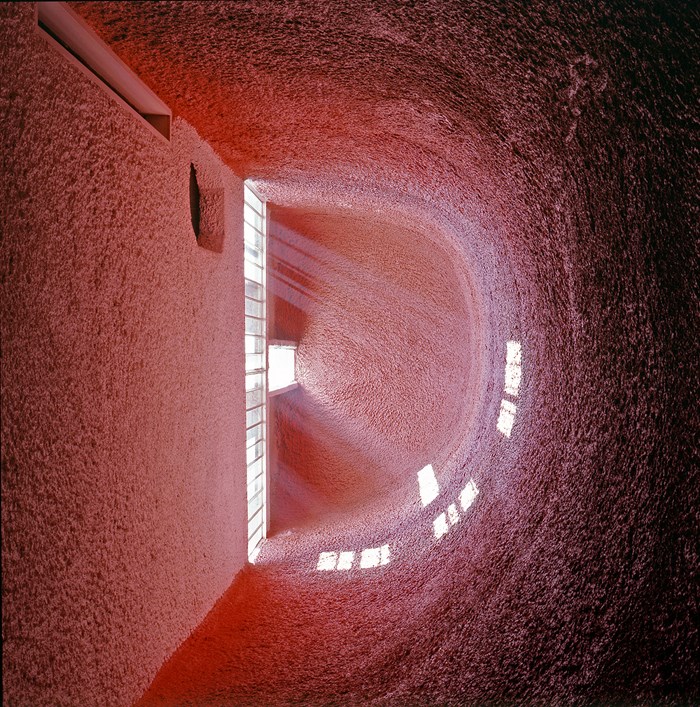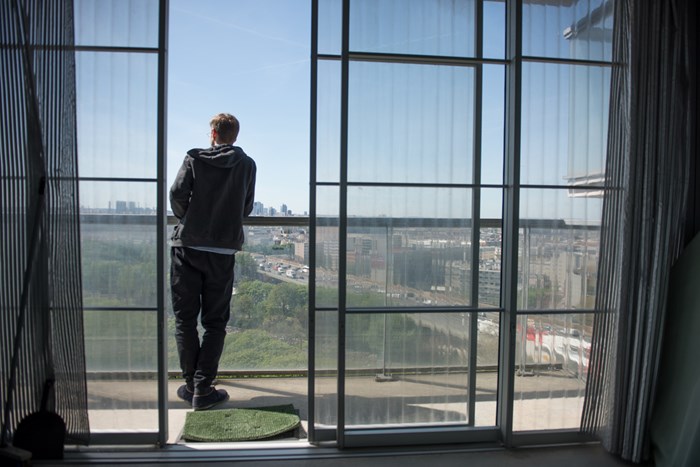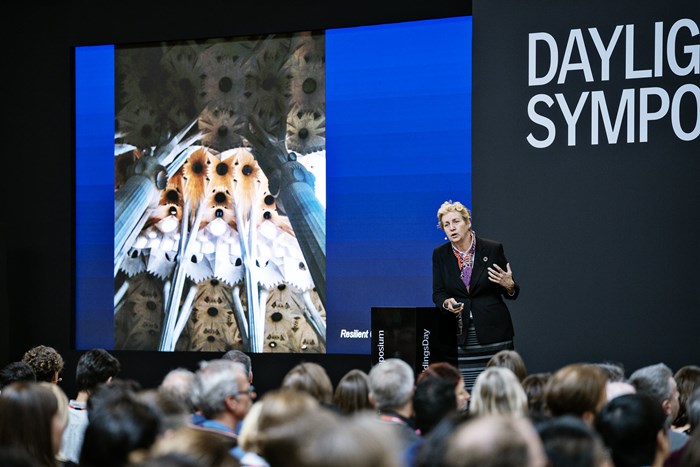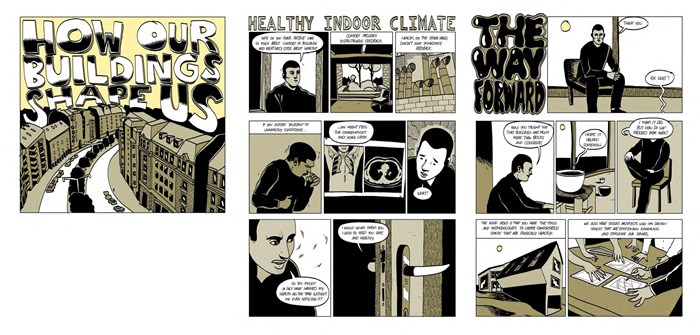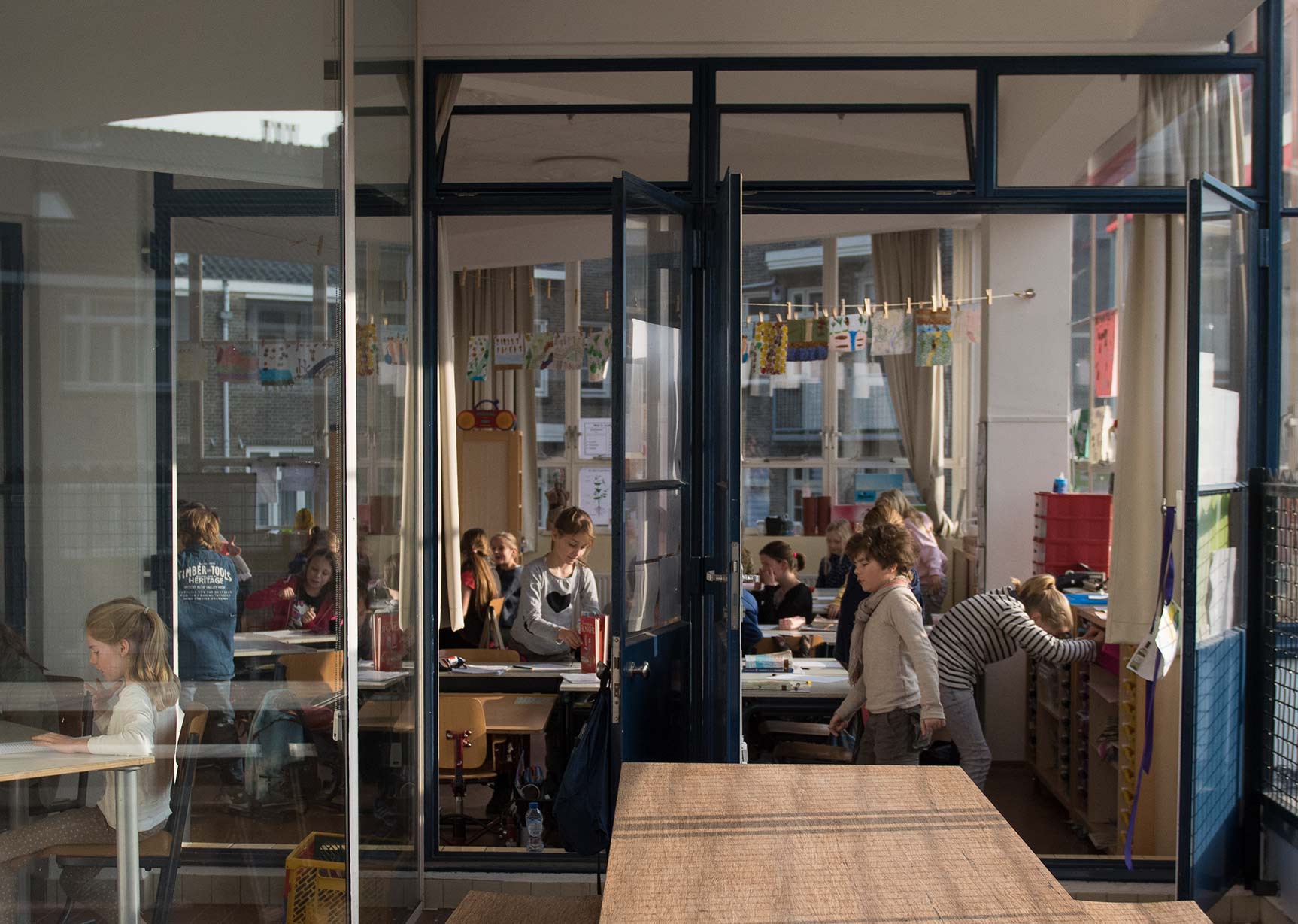
For the past 50 years, buildings have been designed much like spaceships, sealed and served by continuously running machinery to ensure occupant comfort and well-being. This article puts forward a different vision instead: one of buildings that literally ‘surf’ through the days and seasons of the year, employing windows to harness the renewable forces of nature and to ensure sustainability, resiliency, health and sheer delight.
By Vivian Loftness
To even dream of carbon neutrality, we need nature’s renewables: daylight, natural ventilation, natural cooling, and passive solar heating. We need active systems that are idle for as long as possible and buildings that ‘surf’ through hours, days, months, and seasons by capturing nature’s sun, wind, and comfortable temperatures. The beauty of buildings that environmentally surf goes beyond the conservation of energy and water, the reduction of carbon, and the promise of resilience in the face of climate change. Buildings that environmentally surf support health, productivity, and a higher quality of life.
Most of the energy used in buildings is for heating, lighting, cooling and ventilation. In contrast, sustainable buildings run for as many hours, days and months as possible on natural conditioning: daylighting, natural ventilation, night cooling and passive solar heating. Embracing nature region by region, these buildings sustain limited resources by preserving, then surfing, cascading, and regenerating nature’s resources1. Moreover, these buildings go well beyond conservation and resiliency to connect building occupants with a richness that is critical to human health and well-being.
Beginning with a Detailed and Layered Commitment to Windows
Windows play an invaluable role in environmental sustainability, defining our access to: nature and views, daylight, natural ventilation and night cooling, heat loss/heat gain control, solar control, load balancing (windows as circulatory system), passive and active solar energies, as well as the circadian, seasonal, cultural and climatic richness of each building’s context. While designers and occupants alike have an innate knowledge of this richness, the building community must renew its commitment to outstanding window design and specification, fully resolving all of the design choices with climate specific intensity.
In Northern Europe, for example, windows should be designed for daylighting without glare, the minimisation of heat loss/heat gain and thermal bridging, winter solar gain without summer overheating, natural and stack ventilation without rain or pests, the maximisation of load balancing − with windows to help dissipate heat, and outstanding views and connections to nature and community. The design solutions go well beyond the plane of the glass to include layers outside, within, and inside the glazing. In commercial buildings, the breadth of facade design decisions might be defined in 12 fields – the transom, viewing field, window parapet, and spandrel panels (top to bottom), and the interior, integral and exterior layers (inside to out) – with changing priorities relative to each performance outcome.
The creative resolution of these design decisions is central to environmental sustainability and our quality of life.
Surfing Sunlight for Heat
Heating is the largest site energy load in US and European buildings, both residential and commercial2. Highly insulated building enclosures, high efficiency mechanical systems, and heat recovery strategies do yield significant benefits for buildings today, reducing heating loads by 30–50 per cent in offices3. The giant leap in energy savings, however, is achieved by buildings also designed with passive solar heating as the dominant heat source
− surfing for 60–90 per cent of the time without mechanical intervention.
Passive solar heating can provide toasty winter spaces without an energy penalty, approaching complete independence and carbon neutrality when combined with deep conservation. Surfing for solar heat also provides full spectrum light which supports health, eliminates pathogens, and reduces the risk of mould. Research findings reveal that early morning sunlight is critical to our sleep cycles and to healthier, more attentive students4; and sunnier hospital rooms have been linked to faster recovery rates and reduced levels of medication5.
Even though heating is the largest energy demand in US and European buildings, designers often block sunlight through poor window orientation and sizing, low transmission glass and unmanageable layers. A building dynamically designed to capture solar heat precisely during the hours and seasons when heating is needed, while eliminating glare and solar overheating, brings energy innovation together with health and thermal delight. For homes, the outdoor temperature at which heating is needed can be shifted from 18°C (the typical degree day base) to a new “balance point” temperature below 10°C before any heating is needed10.
Solar overheating in summer can be dramatically reduced by integrating external, integral or, at the very least, interior shading devices and by natural venting when outdoor temperatures are cool. This is solar surfing at its best.
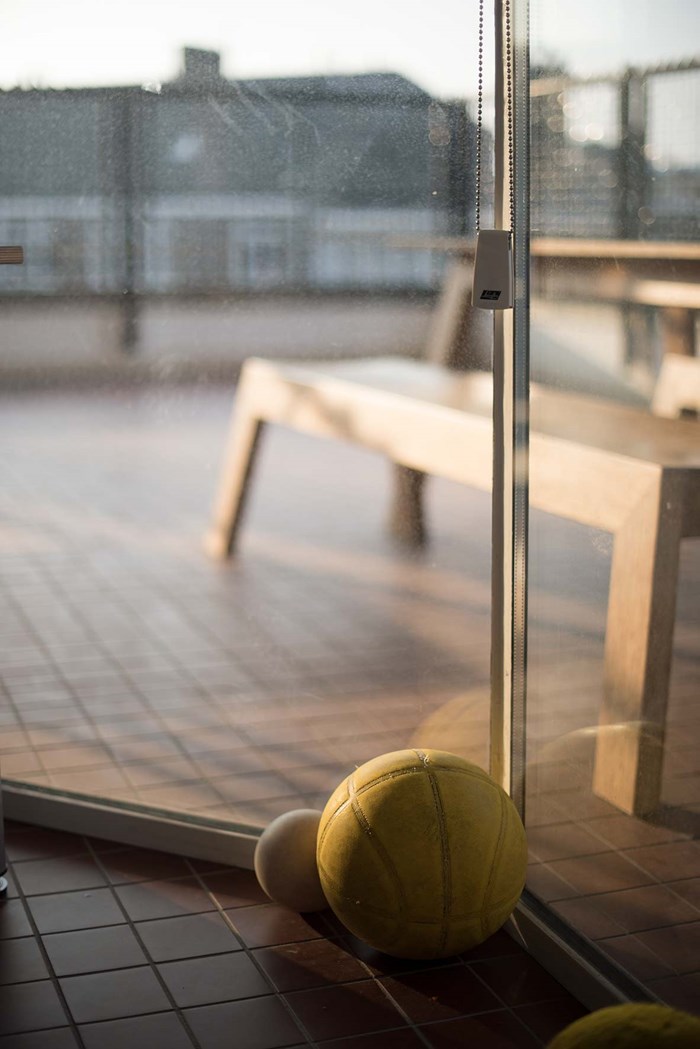

Windows play an invaluable role in environmental sustainability, defining our access to nature and views, daylight, natural ventilation and night cooling as well as the circadian, seasonal, cultural and climatic richness of each building’s context.
Sunlight = Health
In a 1996 observational field study of 174 patients at a hospital in Edmonton, Alberta, Canada, Beauchemin & Hays identified a 2.6-day reduction in length of stay among seasonal affective disorder patients located in sunny rooms, as compared to those in sunless rooms. Patients were randomly assigned to rooms, and the difference in length of stay was consistent across seasons.6
Benedetti et al found similar benefits with respect to hospitalisation for bipolar disorder in a field study of 187 inpatients at San Raffaele Hospital in Milan, Italy in 2001. The researchers identified a 30% reduction in length of stay in summer and a 26% reduction in length of stay in autumn among patients in eastern rooms (exposed to direct sunlight in the morning) as compared to patients in western rooms (exposed to direct sunlight in the evening).7
Walch et al identified a 22% reduction in analgesic medication use among patients in “bright” rooms who were exposed to more natural sunlight after surgery (average 73,537 lux-hrs), as compared to patients located in “dim” rooms after surgery (average 50,410 lux-hrs of sunlight) in a 2005 prospective study of 89 elective cervical and lumbar spinal surgery patients at Montefiore Hospital in Pittsburgh, PA.8
In a 2005 building case study of Inha University Hospital in Korea, Choi identified a 41% reduction (3.2 days) in average length of stay among gynaecology patients in the spring in brightly daylit rooms (317 lux average), as compared to those in dull rooms, and an average 26% reduction (1.9 days) in average length of stay among surgery ward patients in the autumn in bright rooms, as compared to those in dull rooms. Across all seasons, the average daylight illuminance in bright rooms was 317 lux, compared to 190 lux in dull rooms.9
Surfing for Free Cooling and Fresh Air
Building insulation, shading, and energy efficient hvac systems are obvious first steps for 30–50% per cent energy savings in air conditioning loads. The giant leap however, is achieved by buildings designed with natural cooling as the dominant cooling source − surfing for nature’s cooler air and diurnal temperature swings for up to 90 per cent of the time in the case of office buildings.
This leap in energy savings requires rediscovering the crossand stack ventilation techniques of previous generations, as well as the use of thermal mass orphase change materials and earth sheltering to delay the heat of the day until cooler times at night, then to hold the cool of the night to absorb the heat of the next day. These traditional design approaches for cooling with nature − daytime and night ventilation, evaporative cooling, time lag construction, and ground source cooling such as earth tubes − can be advanced significantly through twenty-first century material and assembly innovations.
Windows play a critical role in natural ventilation with placement, sizing, operability and mechanical system interface critical to extending the period of ‘environmental surfing’ for free cooling. For buildings or climates that cannot meet all cooling demands naturally, mixed-mode conditioning complements natural cooling with mechanical cooling and ventilation strategies, pursuing concurrent, zoned or seasonal changeover integration11 representing one of the most cutting edge areas of development for zero-energy buildings.
Surfing for breathing air may be even more important than surfing for natural cooling, because resiliency and human health are often unmet challenges in sealed buildings.
When we seal our buildings, mechanical ventilation becomes mandatory year round, reaching 20 per cent of the total load in US commercial buildings. Innovations in mechanical systems – economiser cycles, occupant-responsive controls, variable-speed fans, task air, desiccant air handlers and heat recovery – can substantially reduce ventilation energy use. The giant leap, however, can only be achieved when buildings are designed with natural ventilation as the dominant strategy for as many hours, days and seasons as possible, so that renewable energies can truly meet the remaining mechanical cooling and ventilation loads.
Human beings have thrived without forced air systems for centuries. Natural ventilation is not only a viable method to deliver outdoor air, in substantially higher quantities than forced air systems, it can also deliver cooling whenever the outdoor temperatures are within or below comfort levels. In the autumn, winter, and spring, a classroom filled with students can and should be conditioned with ‘free ventilation and free cooling’ through operable windows.
Designing windows and building volumes for effective natural ventilation − without drafts, rain penetration, noise, humidity and pollution – is the basis of design excellence.
Naturally ventilated homes, classrooms, offices, hospitals, gymnasiums and other spaces also contribute to greater health and performance outcomes. Air change rates in naturally ventilated spaces can be higher, improving air quality without energy penalty; the cooling effect of air flow allows for a broader range of acceptable temperatures (known as the adaptive comfort zone); and the variability enhances motivation and creativity.
Open windows also ensure a connection to the multisensory qualities of nature and community.
The quantifiable benefits of surfing for natural cooling and ventilation are substantial – measurably improving indoor air quality for productivity and health, as well as saving energy and ensuring resiliency in the face of power blackouts. Research findings reveal that natural cooling and ventilation reduces absenteeism and medical attention as well as increasing productivity.
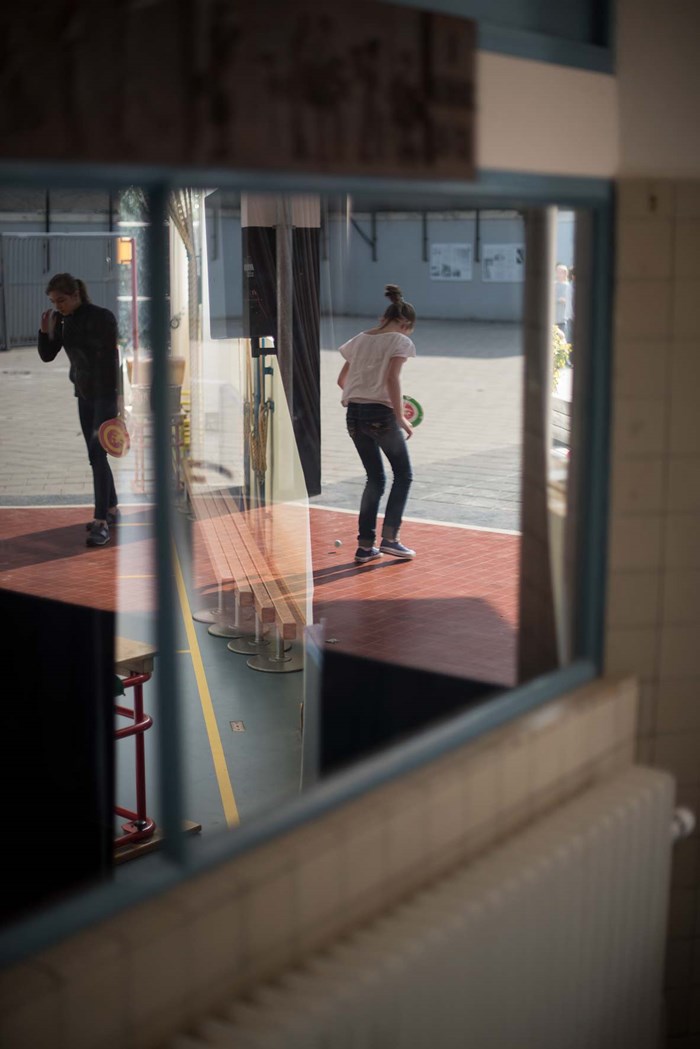
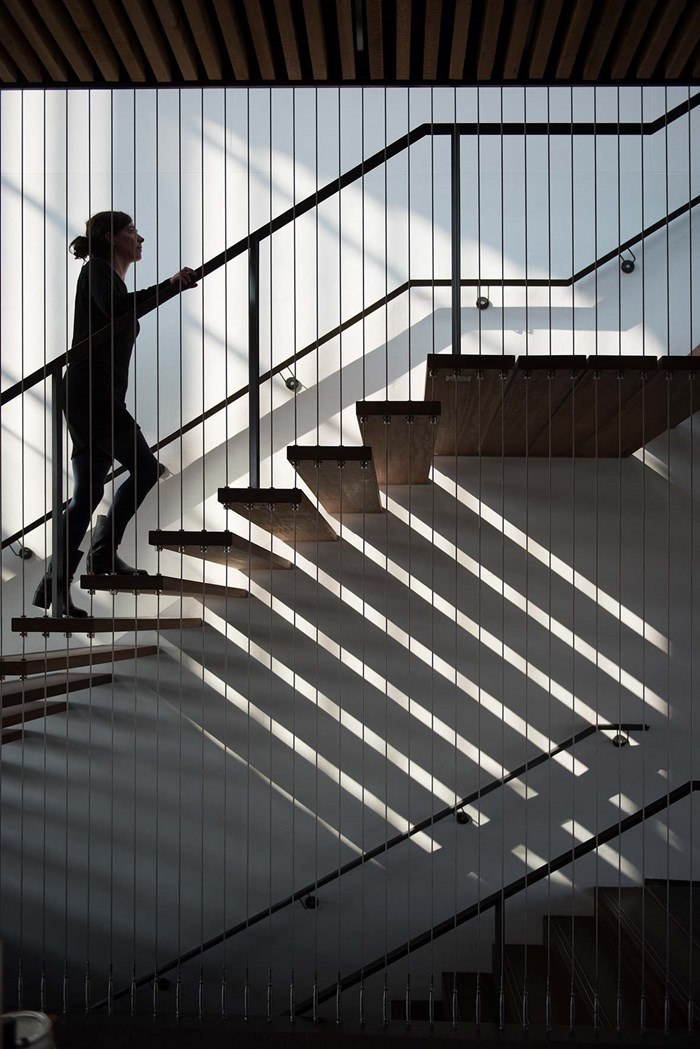
Night ventilation cooling = Productivity
In a 2003 meta-analysis study, Seppänen et al identify a productivity increase equivalent to 0.39 hours of work per day (4.9% for an eight-hour workday) due to night-time ventilation cooling of thermal mass, a very energy-efficient method of reducing daytime indoor temperatures by using night-time air to cool a building’s structure and furnishings.12
Natural ventilation = Health + Productivity
In a 2004 multiple-building study of professional middle-aged women in France, Preziosi et al identify a 57.1% reduction in absenteeism, a 16.7% reduction in medical services use (doctor visits), and a 34.8% reduction in hospital stays among subjects with natural ventilation in their workplace, as compared to those with air conditioning.13
Surfing for Light
Energy-efficient lamps, ballasts and light fixtures are obvious first steps for achieving a 30 per cent saving in lighting energy, and daylight and occupancy-responsive controls can shave the next 20 per cent of lighting energy use14. The giant leap, however, is achieved by buildings designed with daylighting as the dominant light source − surfing for daylight to eliminate any electricity demand for lighting during the daytime. Daylight as the dominant light source requires design excellence and management expertise, integrating space planning with windows and skylights, advanced glazing technologies, light redirection devices and shading layers that enrich and regionalise our architecture.
Daylit classrooms, offices, hospitals, gyms, airports, grocery stores and other spaces also contribute to greater health and performance outcomes. Light levels in daylit spaces can be higher with no energy penalty; full-spectrum light offers rich colour rendition and improves three-dimensional perception; and daylight variations throughout the day trigger melatonin production, circadian rhythms and healthy sleep patterns15. As an added benefit, views afforded through windows and other transparent surfaces meet fundamental needs for a connection to nature 16.
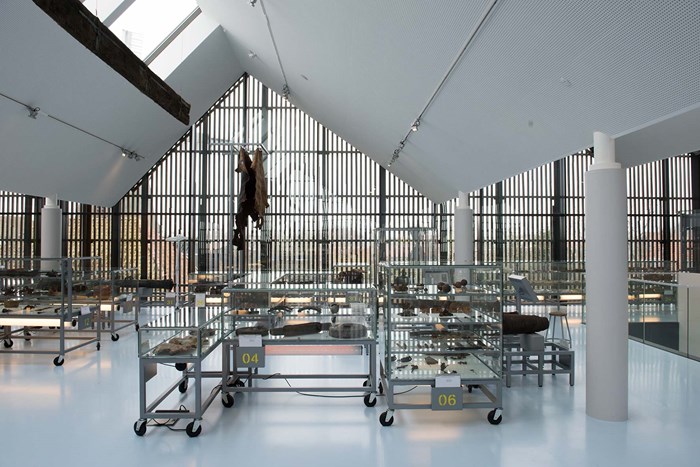
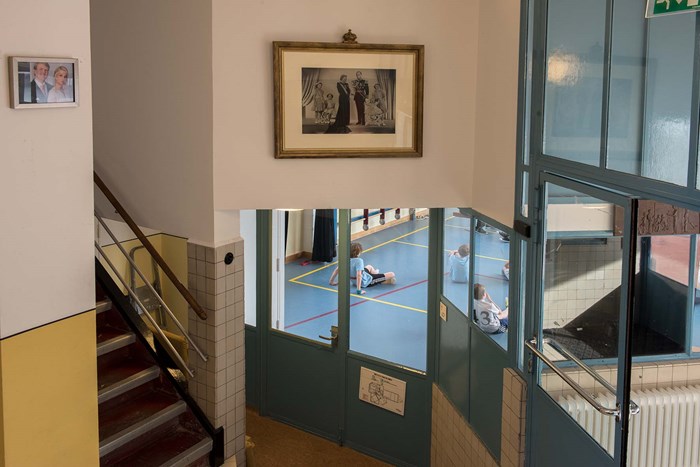
Daylight = Productivity
In a 1997 controlled experiment, Boyce et al identify a 1.6-12.8% improvement in night-shift workers’ performance on short-term memory and logical reasoning tasks under large skylight-simulating fixtures with hidden fluorescent lamps, capable of providing fixed or variable illuminance from 200 lux to 2,800 lux. Performance was enhanced by fixed high illuminance of 2,800 lux and by steadily decreasing illuminance that simulated daylight from midday to dusk, as compared to fixed low illuminance of 250 lux or steadily increasing illuminance that simulated daylight from dawn to midday.17
Daylight = Sleep cycles (and performance)
In a 2010 study of sleep cycles of 8th grade students in the Smith Middle School in Chapel Hill, USA, Figuero and Rea identify that student exposure to short-wavelength morning light significantly regulates their circadian clock and improves sleep times by as much as 30 min.
Wolfson and Carskadon (1998) identified that poor-performing students obtained about 25 minutes less sleep per night and went to bed on average 40 minutes later on school nights than those who were good performers.18
Window View of Nature = Health
In a 1984 observational field study at a Pennsylvania hospital, Ulrich identifies an 8.5% reduction in post-operative hospital stay (8.7 days versus 7.96 days) for gall bladder surgery patients who had a view of a natural scene from their hospital room, as compared to those with a view of a brick wall. Patients with a view of a natural scene also received fewer negative evaluations from nurses and took fewer strong analgesics.19
Window View of Nature = Productivity
In a 2003 building case study of the Sacramento Municipal Utility District (SMUD) Call Center, Heschong et al identify a 6% to 7% faster Average Handling Time (AHT) for employees with seated access to views through larger windows with vegetation content from their cubicles, as compared to employees with no view of the outdoors.20
Surfing the Regenerative Forces of Nature
Design for environmental surfing maximises the number of hours, days, months and seasons in which ‘passive renewables’ − such as daylight, natural ventilation, passive solar heating and time-lag cooling − allow mechanical and electrical systems to be turned off. This is the only way we can achieve the 90 per cent reductions in building loads that take full advantage of active renewable sources.
Design for environmental surfing, however, challenges architects and engineers to collaborate on regional design solutions, merging traditional and innovative materials and systems to create or re-create buildings that are indigenous to each climate. The joy of summer days and nights in unsealed, naturally-conditioned spaces in the Raffles Hotel in Singapore, the Mohonk Mountain House in New York State, Sagrada Familia in Barcelona − each unique to its climate and truly low energy consumption − are irreplaceable experiences. Regionally appropriate designs are critical for zero-energy buildings and for the cultural richness that make travelling and living a unique celebration of place.
Moreover, design for environmental surfing will ensure that our architecture is filled with ‘biophilic’ richness for health, productivity and all of the natural energies that offer an abundance of light, heat, coll and air. ‘Biophilia,’ a term coined by E.O. Wilson21 with deep elaboration by Stephen Kellert22, is the innate human need for a connection to nature and living systems. Windows play a critical role in environmental surfing as well as being central to our connection with nature and community, and emerging research is helping to quantify these benefits23.
Triple Bottom Line Approaches to Valuing Windows for Environmental Surfing
Cars and laptops are purchased with far more comprehensive life-cycle considerations than buildings, and yet the life span of cars and laptops are often five years or less. Since buildings are built for 30, 50 or even hundreds of years, it is imperative that the client and design community begin to understand the “triple bottom line” benefits of buildings designed to ensure cost-effective environmental sustainability and resiliency as well as human health and productivity.
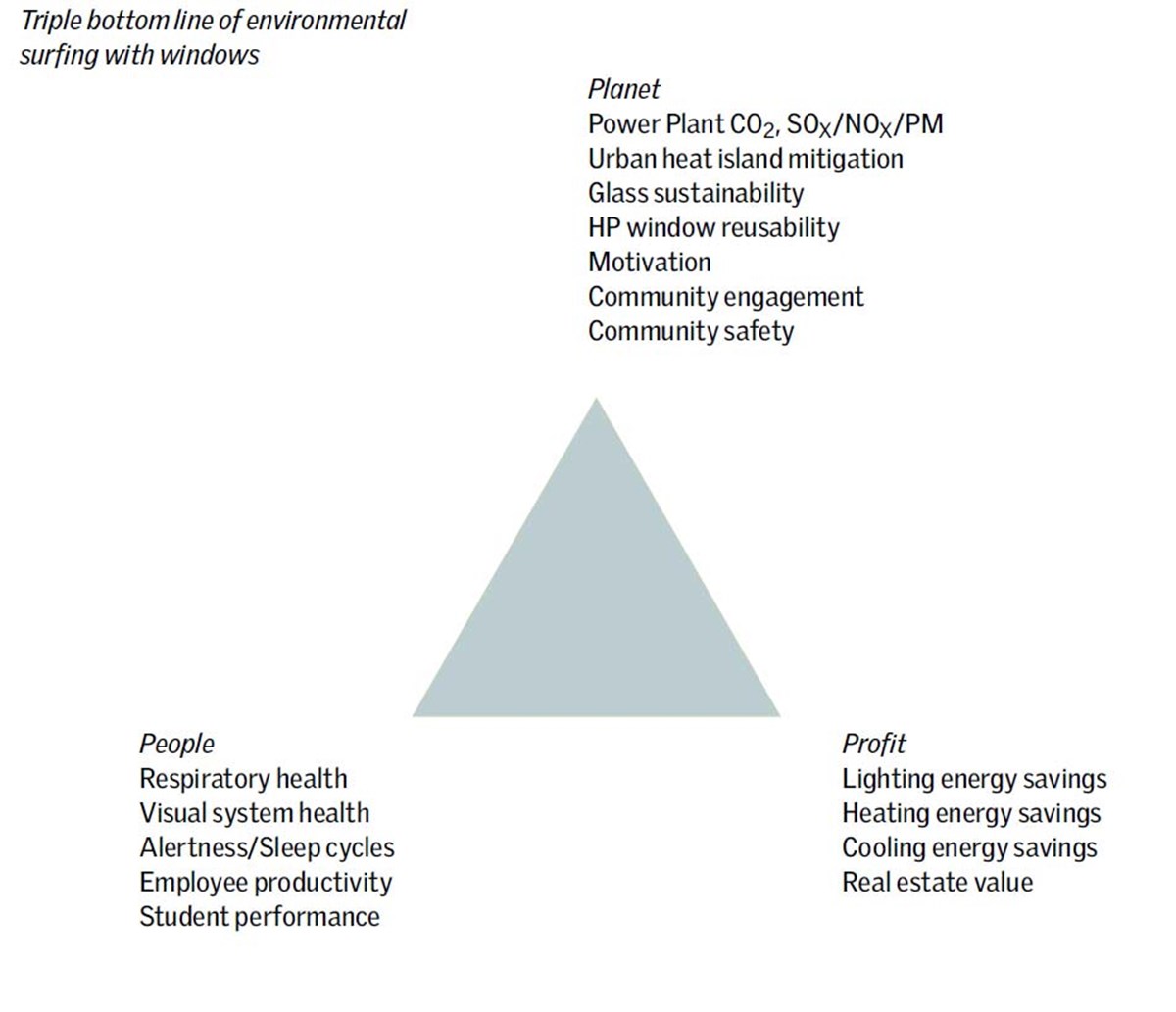
Balancing profit, planet, place or financial capital, natural capital and human capital, is a shift in decision-making that is critically needed for the built environment. With triple bottom line calculations, building decisions will move beyond first least-cost and ‘value-engineering’ budget cuts to reflect the true cost of ownership for individuals and society. It is actually not difficult to monetise triple bottom line benefits once they are understood. The environmental cost benefits of energy use, waste and toxicity can be quantified and put in an npv calculation, even if assumptions must be made.
The human cost benefits of health, productivity, performance at task, market impacts can also be monetised and calculated, creating an iterative triple-bottom-line for decision makers to understand the true value of their investments. If we want to shift away from first-least-cost decision making, the design community and the building industry must capture the economic, environmental and human benefits of investing in quality built environments.
This article has listed a host of human capital benefits to environmental surfing through the integration of high-performance windows that can be justified in a triple bottom line calculation. For example, daylight without glare, with controlled heat loss and heat gain, with passive solar heating in winter, with no solar overheating in summer, can only be achieved through high-performance specifications of visual transmittance, value, solar heat gain coefficient, thermal bridge control and layers that support daylight redistribution, shading, night insulation and more. High-performance specifications should cost more. While energy savings through environmental surfing (a profit calculation) will probably not pay for the high performance window assembly in less than five years, the health and productivity benefits (a people calculation) most certainly will. A triple bottom line calculation for new, selectively reflective high-performance blinds that are inverted for daylight redirection, for example, reveals a 19-year payback based on energy and maintenance, 15-year payback if environmental costs associated with energy are no longer externalities, and a one-year payback when human health and performance gains are considered24.
Life cycle, triple bottom line calculations can ensure investments in high performance windows that support environmentally surfing for − views, daylight, sunlight, fresh air, breezes, natural comfort, passive survivability, access to outdoor spaces and activities, seasons, climate and the full sensory richness of nature and community outdoors.
The biophilic advantages of windows
Views
Access to nature
Sounds of nature
Smells of nature
Sensory feel of nature
Daylight
Sunlight and Solar Heat
Shade with light
Fresh Air and Natural Ventilation
Thermal delight
Resiliency
Transparency
Community
Celebration of time and place
Masters of Environmental Surfing
The architectural masters of environmental surfing will preserve, cascade, and regenerate nature’s abundant resources for sheer delight; create technologies that mimic nature and regenerate without waste; and ensure shared access to revitalised natural settings, healthy lifestyles, mobility, community. The architecture that environmentally surfs reflects the uniqueness of each climate, culture and community; dynamically responds to the time of day and the seasons; and celebrates nature’s creative energies.
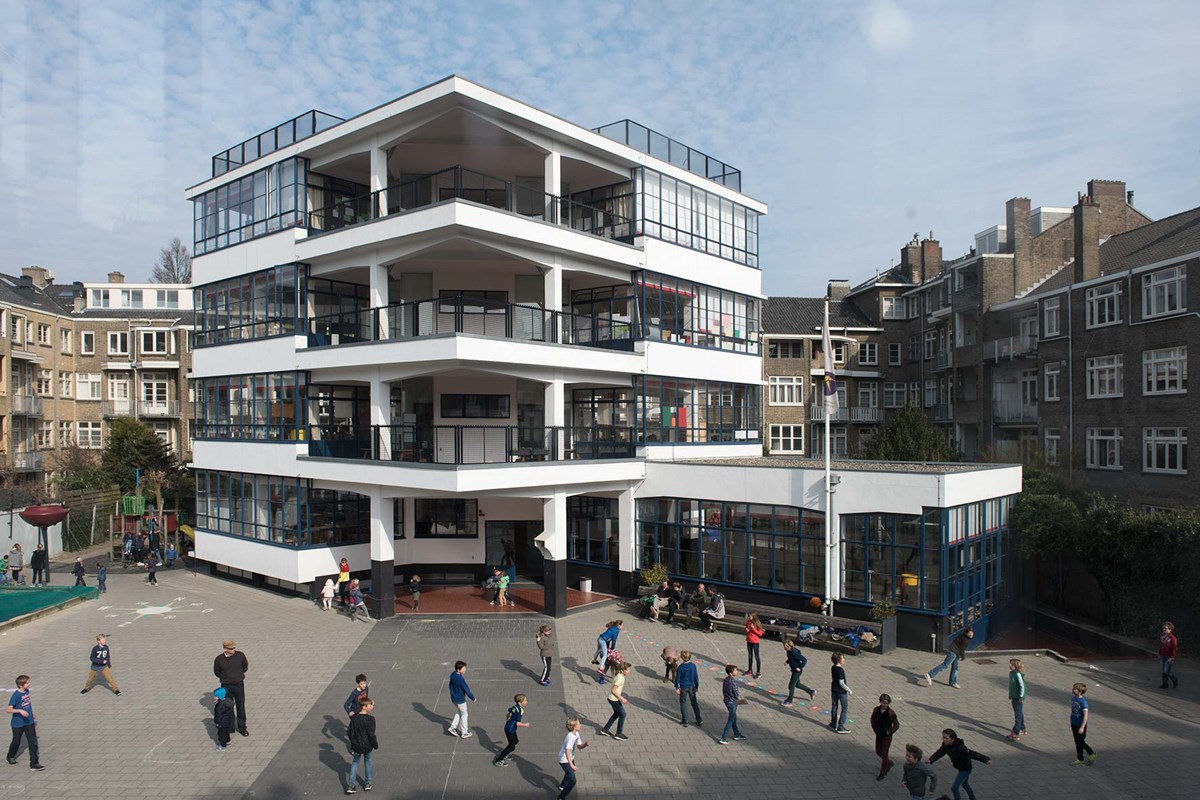
"Balancing financial capital, natural capital and human capital is a shift in decisionmaking that is critically needed for the built environment."
Vivian Loftness is a University Professor and the Paul Mellon Chair of Architecture at Carnegie Mellon University. She is a Fellow of the American Institute of Architects (AIA), a LEED Fellow, a Fellow of the Design Futures Council, and was awarded a USGBC’s Sacred Tree Award as well as an AIAS Educator of the Year Award.
Notes
1.Four terms have been introduced to add depth to the overall thesis on environmental surfing: preserve is used to summarise the ben- efits of conservation, using as few resources as needed; surf is used to summarise the benefits of passive conditioning with non-depletable natural resources such as light, sun, wind, diurnal swing; cascade is used to summarise strategies to use depletable natural resources several times by recapturing the waste stream (energy, water, materials) for secondary and then tertiary uses with a goal of zero waste; regenerate is used to summarise the potential of actually increasing a resource such as fresh water through innovative technologies and design solutions.
2. http://www.eia.gov/consumption/commercial/data/archive/cbecs/cbecs2003/de- tailed_tables_2003/2003set19/2003html/ e01.html
3. According to calculations performed by V. Loftness and Y. Hua at the Center for Building Performance and Diagnostics, Carnegie Mellon University, 2009.
4. M.G. Figueiro & M. S. Rea, Lack of short Wavelength Light durign the School Day Delays Dim Light Melatonin Onset (DLMO) in Middle School Students, Lighting Research Center, Rensselaer Polytechnic Institute, Troy, Feb- ruary 2010.
5. J. M. Walch, B. S. Rabin, R. Day, J. Williams, K. Choi, & J. Kang, The Effect of Sunlight on Postoperative Analgesic Medication Use: A Prospective Study of Patients Undergoing Spinal Surgery,” Psychosomatic Medicine, 67, (2005), pp. 156–163.
6. K. M. Beauchemin, & P. Hays. (1996) Sunny Hospital Rooms Expedite Recovery from Severe and Refractory Depression. Journal of Affective Disorders, v.40, pp. 49–51.
7. F. Benedetti et al. (2001). Morning sunlight reduces length of hospitalisation in bipolar depression, Journal of Affective Disorders, v.62, pp.221–223.
8. J. Walch et al (2005). The effect of sunlight on post-operative analgesic medication use: a prospective study of patients undergoing spinal surgery. Journal of Psychosomatic Medicine, 67, pp. 156–163.
9. J. Choi (2005). Study of the Relationship between Indoor Daylight Environments and Patient Average Length of Stay (ALOS) in Healthcare Facilities, Unpublished master’s thesis, Department of Architecture, Texas A&M University. College Station, TX.
10. Balance point temperature is the outdoor condition at which heating will be needed given the quality of the construction. Typically set at 18°C, balance point temperature is the basis of heating degree days. Given internal heat gains from people and equipment, super insulated buildings can lower the balance point temperature by 5–15 °C, and the addi- tion of passive solar can lower it even further, eliminating the need for mechanical heating for most of the winter. For a detailed explanation see: Michael Utzinger and James Wasley, Building Balance Point, published in The Vital Signs Project 1996 Curriculum Materials.
11. http://www.cbe.berkeley.edu/research/ briefs-mixedmode.htm
12. O. Seppänen & W. J. Fisk (2002) Association of ventilation system type with SBS symptoms in office workers. Indoor Air 12(2): 98–112.
13. P. Preziosi, S. Czerniichow, P. Gehanno & S. Hercberg (2004) Workplace air-conditioning and health services attendance among French middle-aged women: a prospective cohort study. International Journal of Epidemiology, 33(5), pp.1120–1123.
14. A. Williams B. Atkinson, K. Garbesi & F. Rubinstein, A Meta-Analysis of Energy Savings from Lighting Controls in Commercial Buildings LBNL-5095, Sept 2011.
15. Figuero and Rea 2010, op.cit.
16. Heschong, Mahone Group Inc., Windows and Offices: A study of Office Worker Performance and the Indoor Environments, California Energy Commission Technical Report, (2003).
17. P.R. Boyce, J.W. Beckstead, N.H. Eklund, R.W. Strobel & M.S. Rea (1997). Lighting the Graveyard Shift: The Influence of a daylight-simulating skylight on the task performance and mood of night-shift workers. Lighting Re- search and Technology 29(3), 105–134.
18. R. Ulrich (1984) View Through a Window May Influence Recovery From Surgery. Science, 224(4647), pp.420–421.
19. M. G. Figueiro (2013). An Overview of the Effects of Light on Human Circadian Rhythms: Implications for New Light Sources and Lighting Systems Design; Journal of Light & Visual Environment Vol.37, No.2 & 3, 2013; and Lighting Research Center, Rensselaer Polytechnic Institute, USA.
20. Heschong, Mahone Group, Inc. (2003) Windows and Offices : A study of office worker performance and the indoor environments, California Energy Commission Technical Report; http://www.energy.ca.gov/2003publications/CEC-500-2003-082/CEC-500- 2003-082-A-09.PDF
21. E. O. Wilson, Biophilia - The Human bond with Other Species, Harvard University Press, third impression edition, January 1984.
22. S. Kellert, J. Heerwagen & M. Mador, Biophilic Design: The Theory, Science and Practice of Bringing Buildings to Life, New Jersey, John Wiley & Sons inc, February 2008.
23. Terrapin Bright Green, The Economics of Biophilia: Why Designing with Nature in Mind Makes Financial Sense, 2012. http://www. terrapinbrightgreen.com/report/economics- of-biophilia/
24. V. Loftness & R. Srivastava, Presentation at the IES Annual Conference, Pittsburgh, November 2014, https://docs.google.com/file/ d/0BwzeW6TtQrCdYXdOUXFsZ3ZMYnc/ edit?pl
Key contributing publications
LOFTNESS, Vivian; SRIVASTAVA, Rohini; DADIA, Devanshi and PAREKH, Hetal with RAWAL, Rajan; SHAH, Agam; The Triple Bottom Line Benefits of Climate Responsive Dynamic Facades, Proceedings of PLEA 2014, Ahmedabad, India, December 2014.
LOFTNESS, Vivian and FORMAN, Avi; The Cost of Building Trash, Perspecta 47: Money, October 2014.
LOFTNESS, Vivian; Environmental Surfing: delight and nature’s renewable energies, chapter in Architecture and Energy: Performance and Style, W. Braham and D. Willis, Abingdon/New York: Routledge Press, June 2013.
HARTKOPF, Volker; AZIZ, Azizan and LOFTNESS, Vivian; High Performance Building Facades – Enclosures for Sustainability, chapter in Springer Reference Encyclopedia Sustainable Built Environments, V. Loftness and D. Haase (Eds.), Leipzig; Springer Science 2013.
LOFTNESS, Vivian and SNYDER, Megan; Sustainable and Healthy Built Environment, chapter in Springer Reference Encyclopedia Sustainable Built Environments, V. Loftness and D. Haase (Eds.), Leipzig; Springer Science 2013.
LOFTNESS, Vivian and SNYDER, Megan; Where Windows Become Doors, chapter in Biophilic Design Theory, Science and Practice, S. Kellert et al (Ed.), Hoboken: John Wiley 2007.
Terrapin Bright Green LLC, The Economics of Biophilia: Why Designing with Nature in Mind Makes Financial Sense, 2012; http://www. terrapinbrightgreen.com/report/economics- of-biophilia/
KELLERT, Stephen: Building for Life: Designing the Human-Nature Connection. Washington, DC: Island Press 2005.
